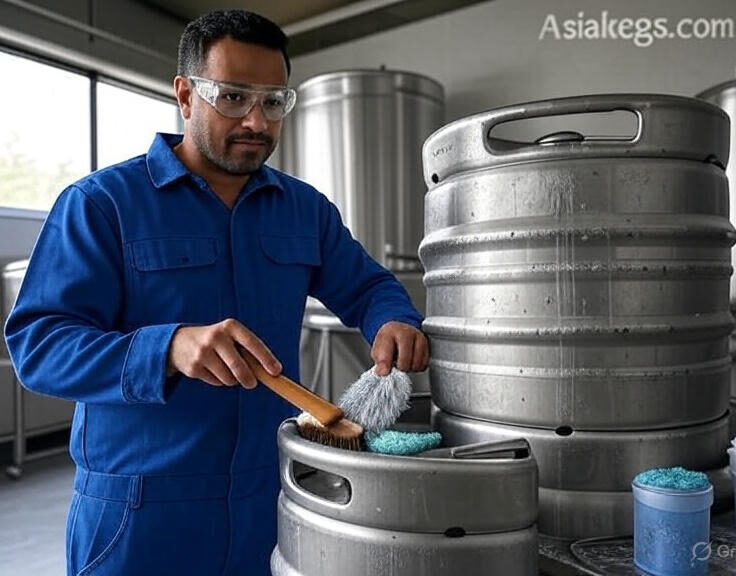Maintaining and cleaning beer kegs is essential for any brewery or bar aiming to deliver top-quality craft beer. Dirty or poorly maintained kegs can lead to contamination, off-flavors, and wasted product, damaging your reputation and bottom line. At Asiakegs.com, we’re committed to helping you keep your kegs in peak condition.
Why Keg Maintenance Matters
Clean kegs are the backbone of a successful beer operation. Contamination from bacteria, yeast, or residue can spoil beer, affecting taste and safety. Regular maintenance extends keg lifespan, reduces waste, and ensures consistent quality. For craft breweries and bars, where every pour counts, proper care is non-negotiable. Asiakegs.com provides durable stainless steel kegs designed for easy upkeep, setting the foundation for success.
Initial Inspection Before Cleaning
Start by inspecting your keg for damage or wear. Check for dents, leaks, or corrosion, especially on stainless steel surfaces. Ensure fittings and valves are intact and functional. A damaged keg should be repaired or replaced to avoid safety hazards. At Asiakegs.com, our kegs are built to withstand rigorous use, but routine checks are key to identifying issues early.
Step-by-Step Cleaning Process
1. Disassemble the Keg
Remove all fittings, valves, and spears (if applicable) according to the manufacturer’s instructions. Disassembling ensures every part is thoroughly cleaned. Use tools like a keg wrench for safe removal. Asiakegs.com kegs come with user-friendly designs to simplify this step.
2. Rinse with Cold Water
Flush the keg with cold water immediately after emptying to remove loose debris and beer residue. This prevents buildup from hardening. Avoid hot water initially, as it can set proteins and make cleaning harder.
3. Use a Cleaning Solution
Prepare a cleaning solution using a brewery-approved cleaner, such as caustic soda or peracetic acid, diluted per instructions. Fill the keg and circulate the solution using a pump or manual agitation. This breaks down organic matter and sanitizes the interior. Always follow safety guidelines when handling chemicals.
4. Scrub and Brush
Use a keg brush to scrub the interior, focusing on corners and seams where residue accumulates. For fittings, use smaller brushes or soak them separately. Stainless steel kegs from Asiakegs.com have smooth interiors, making scrubbing efficient.
5. Rinse Thoroughly
Rinse multiple times with clean water to remove all cleaning agents. Residual chemicals can alter beer flavor or corrode metal. Ensure no suds or odor remain before proceeding.
6. Sanitize the Keg
Apply a food-grade sanitizer, such as iodine-based or quaternary ammonium solutions, to kill remaining bacteria. Circulate the sanitizer and let it sit for the recommended time (usually 1-2 minutes). Rinse again with water if required by the sanitizer’s instructions.
7. Reassemble and Store
Reattach all parts, ensuring tight seals. Store the keg upside down or with the lid off in a dry, ventilated area to prevent moisture buildup. Asiakegs.com offers kegs with secure fittings to streamline reassembly.
Frequency of Cleaning
Clean kegs after every use to prevent contamination, especially if switching beer types. For kegs in storage, clean and sanitize every 4-6 weeks to maintain hygiene. High-use environments may require more frequent checks. Consistent cleaning schedules enhance efficiency and product quality.
Tools and Supplies Needed
Invest in the right tools for effective maintenance:
-
Keg brush (long-handled for interiors)
-
Cleaning and sanitizing agents
-
Pump or pressure system for circulation
-
Protective gear (gloves, goggles)
-
Wrench for disassembly
Asiakegs.com recommends using high-quality supplies compatible with our kegs to ensure optimal results.
Common Maintenance Issues and Solutions
Beer Stone Buildup
Hard water can leave calcium deposits. Use a descaling agent or acid cleaner to dissolve buildup, followed by thorough rinsing.
Stuck Valves
Lubricate valves with food-grade lubricant if they’re stiff. Replace damaged valves promptly to avoid leaks.
Corrosion
Though rare with stainless steel, corrosion can occur with improper cleaning. Use non-abrasive methods and avoid harsh chemicals. Asiakegs.com kegs are corrosion-resistant, reducing this risk.
Best Practices for Longevity
-
Avoid stacking wet kegs to prevent rust or mold.
-
Inspect gaskets regularly and replace worn ones.
-
Label kegs to track cleaning dates and beer types.
-
Train staff on proper procedures to maintain consistency.
These practices extend keg life, saving money over time. Asiakegs.com provides resources to support your maintenance routine.
Environmental Considerations
Cleaning generates wastewater, so use eco-friendly cleaners to minimize environmental impact. Recycle or dispose of cleaning agents responsibly. Stainless steel kegs from Asiakegs.com are reusable, supporting sustainable operations.
Benefits of Well-Maintained Kegs
Clean kegs improve beer taste, reduce waste, and enhance customer satisfaction. They also comply with health regulations, protecting your business from fines. Well-maintained kegs from Asiakegs.com reflect your commitment to quality.
Why Choose Asiakegs.com?
At Asiakegs.com, we offer premium stainless steel kegs designed for easy maintenance and durability. Our products come with cleaning guides and support to keep your operation running smoothly. Whether you’re a small brewery or a large bar, we have the perfect kegs to meet your needs.
Conclusion
Maintaining and cleaning beer kegs is a vital skill for breweries and bars. By following this ultimate guide—inspecting, cleaning, sanitizing, and storing properly—you can ensure top-quality beer and extend keg lifespan. Invest in high-quality kegs and supplies from Asiakegs.com to simplify the process and elevate your craft.
Visit Asiakegs.com today to explore our range and start maintaining your kegs like a pro!






